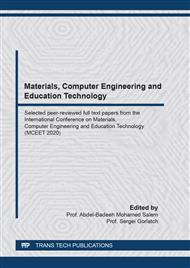[1]
Miller, W.S., et al., Recent development in aluminium alloys for the automotive industry. Materials Science and Engineering: A, 2000. 280(1): pp.37-49.
Google Scholar
[2]
Gungor, B., et al., Mechanical, fatigue and microstructural properties of friction stir welded 5083-H111 and 6082-T651 aluminum alloys. Materials & Design (1980-2015), 2014. 56: pp.84-90.
DOI: 10.1016/j.matdes.2013.10.090
Google Scholar
[3]
Venukumar, S., et al., Failure modes and fatigue behavior of conventional and refilled friction stir spot welds in AA 6061-T6 sheets. International Journal of Fatigue, 2014. 61: pp.93-100.
DOI: 10.1016/j.ijfatigue.2013.12.009
Google Scholar
[4]
Yi, J., et al., Effect of post-weld heat treatment on microstructure and mechanical properties of welded joints of 6061-T6 aluminum alloy. Transactions of Nonferrous Metals Society of China, 2019. 29(10): pp.2035-2046.
DOI: 10.1016/s1003-6326(19)65110-1
Google Scholar
[5]
Singh, T., S.K. Tiwari, and D.K. Shukla, Mechanical and microstructural characterization of friction stir welded AA6061-T6 joints reinforced with nano-sized particles. Materials Characterization, 2020. 159: p.110047.
DOI: 10.1016/j.matchar.2019.110047
Google Scholar
[6]
Singh, R., S. Chauhan, and P.C. Gope, Influence of notch radius and strain rate on the mechanical properties and fracture behavior of TIG-welded 6061 aluminum alloy. Archives of Civil and Mechanical Engineering, 2016. 16(3): pp.513-523.
DOI: 10.1016/j.acme.2016.01.002
Google Scholar
[7]
Mahto, R.P., et al., A comprehensive study on force, temperature, mechanical properties and micro-structural characterizations in friction stir lap welding of dissimilar materials (AA6061-T6 & AISI304). Journal of Manufacturing Processes, 2018. 31: pp.624-639.
DOI: 10.1016/j.jmapro.2017.12.017
Google Scholar
[8]
Dalwadi, C.G., et al., Examination of Mechanical Properties for Dissimilar Friction Stir Welded Joint of Al Alloy (AA-6061) to PMMA (Acrylic). Materials Today: Proceedings, 2018. 5(2, Part 1): pp.4761-4765.
DOI: 10.1016/j.matpr.2017.12.049
Google Scholar
[9]
Torabi, A.R., et al., Pure mode II fracture analysis of dissimilar Al-Al and Al-Cu friction stir welded joints using the generalized MTS criterion. Theoretical and Applied Fracture Mechanics, 2019. 104: p.102369.
DOI: 10.1016/j.tafmec.2019.102369
Google Scholar
[10]
Lakshminarayanan, A., V. Balasubramanian, and K. Elangovan, Effect of welding processes on tensile properties of AA6061 aluminium alloy joints. International Journal of Advanced Manufacturing Technology, 2009. 40: pp.286-296.
DOI: 10.1007/s00170-007-1325-0
Google Scholar
[11]
Jana, S., et al., Effect of process parameters on abnormal grain growth during friction stir processing of a cast Al alloy. Materials Science and Engineering: A, 2010. 528: p.189–199.
DOI: 10.1016/j.msea.2010.08.049
Google Scholar
[12]
Elatharasan, G. and V.S.S. Kumar, An Experimental Analysis and Optimization of Process Parameter on Friction Stir Welding of AA 6061-T6 Aluminum Alloy using RSM. Procedia Engineering, 2013. 64: pp.1227-1234.
DOI: 10.1016/j.proeng.2013.09.202
Google Scholar
[13]
Milčić, M., et al., Experimental investigation of fatigue properties of FSW in AA2024-T351. Procedia Structural Integrity, 2018. 13: pp.1977-1984.
DOI: 10.1016/j.prostr.2018.12.220
Google Scholar
[14]
Madhavarao, S., et al., Investigation On Mechanical Properties Of Friction Stir Welded Aa7075 & Aa6061 Joints. Materials Today: Proceedings, 2019. 18: pp.2288-2297.
DOI: 10.1016/j.matpr.2019.07.011
Google Scholar
[15]
Ghahremani Moghadam, D. and K. Farhangdoost, Influence of welding parameters on fracture toughness and fatigue crack growth rate in friction stir welded nugget of 2024-T351 aluminum alloy joints. Transactions of Nonferrous Metals Society of China, 2016. 26(10): pp.2567-2585.
DOI: 10.1016/s1003-6326(16)64383-2
Google Scholar
[16]
Dong, P., et al., Effects of welding speed on the microstructure and hardness in friction stir welding joints of 6005A-T6 aluminum alloy. Materials & Design, 2013. 45: pp.524-531.
DOI: 10.1016/j.matdes.2012.09.040
Google Scholar
[17]
Shen, Z., et al., Microstructure and mechanical properties of friction spot welded 6061-T4 aluminum alloy. Materials & Design (1980-2015), 2014. 54: pp.766-778.
DOI: 10.1016/j.matdes.2013.08.021
Google Scholar
[18]
Dialami, N., M. Cervera, and M. Chiumenti, Defect formation and material flow in Friction Stir Welding. European Journal of Mechanics - A/Solids, 2020. 80: p.103912.
DOI: 10.1016/j.euromechsol.2019.103912
Google Scholar


